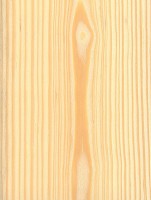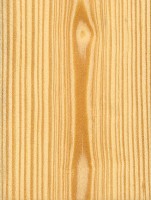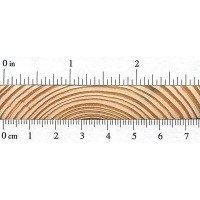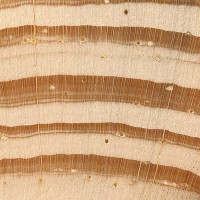 |
Common Name(s): Scots Pine, Scotch pine Scientific Name: Pinus sylvestris Distribution: Native to Europe and northern Asia; Tree Size: 65-115 ft (20-35 m) tall, 2-3 ft (.6-1 m) trunk diameter Average Dried Weight: 34 lbs/ft3 (550 kg/m3) Specific Gravity (Basic, 12% MC): .39, .55 Janka Hardness: 540 lbf (2,420 N) Modulus of Rupture: 12,080 lbf/in2 (83.3 MPa) Elastic Modulus: 1,461,000 lbf/in2 (10.08 GPa) Crushing Strength: 6,020 lbf/in2 (41.5 MPa) Shrinkage: Radial: 5.2%, Tangential: 8.3%, Volumetric: 13.6%, T/R Ratio: 1.6 |
Color/Appearance: Heartwood is light reddish brown, demarcated sapwood is pale yellow to nearly white.
Grain/Texture: Grain is straight, with a medium, even texture.
Endgrain: Medium sized resin canals, numerous and evenly distributed, mostly solitary; earlywood to latewood transition fairly abrupt, color contrast medium; tracheid diameter medium-large.
Rot Resistance: Heartwood is rated as moderately durable to non-durable regarding decay resistance. Scots Pine is readily treated with preservatives and can thereafter be used in exterior applications such as posts or utility poles.
Workability: Scots Pine is easy to work with both hand and machine tools. Glues and finishes well.
Odor: Scots Pine has a mild, resinous odor when being worked.
Allergies/Toxicity: Working with pine has been reported to cause allergic skin reactions and/or asthma-like symptoms in some people. See the articles Wood Allergies and Toxicity and Wood Dust Safety for more information.
Pricing/Availability: Scots Pine is commonly harvested for construction lumber and pulpwood. Expect prices to be moderate within its natural growing range.
Sustainability: This wood species is not listed in the CITES Appendices, and is reported by the IUCN as being a species of least concern.
Common Uses: Utility poles, posts, boxes/crates, flooring, paper (pulpwood), and construction lumber.
Comments: Scots Pine has an enormous distribution, spanning from Portugal in the west out to eastern Siberia. Consequently, there’s also a great amount of natural variability in terms of density, strength, and appearance because of the wide range of growth conditions for the tree. Trees from colder northern climates tend to produce denser, more finely-textured wood because of their slower growth rates.
- Austrian Pine (Pinus nigra)
- Caribbean Pine (Pinus caribaea)
- Eastern White Pine (Pinus strobus)
- Jack Pine (Pinus banksiana)
- Jeffrey Pine (Pinus jeffreyi)
- Khasi Pine (Pinus kesiya)
- Limber Pine (Pinus flexilis)
- Loblolly Pine (Pinus taeda)
- Lodgepole Pine (Pinus contorta)
- Longleaf Pine (Pinus palustris)
- Maritime Pine (Pinus pinaster)
- Ocote Pine (Pinus oocarpa)
- Patula Pine (Pinus patula)
- Pinyon Pine (Pinus edulis)
- Pitch Pine (Pinus rigida)
- Pond Pine (Pinus serotina)
- Ponderosa Pine (Pinus ponderosa)
- Radiata Pine (Pinus radiata)
- Red Pine (Pinus resinosa)
- Sand Pine (Pinus clausa)
- Shortleaf Pine (Pinus echinata)
- Slash Pine (Pinus elliottii)
- Spruce Pine (Pinus glabra)
- Sugar Pine (Pinus lambertiana)
- Sumatran Pine (Pinus merkusii)
- Table Mountain Pine (Pinus pungens)
- Western White Pine (Pinus monticola)
- Virginia Pine (Pinus virginiana)





A turned plate from scots pine
Pesei uma antiga madeira de demolição,sem sombra de dúvida da espécie pinus silvestris, conhecida no Brasil como Pinho de Riga, muito comum em minha cidade, Rio de Janeiro, e encontrei exatos 580K por m3. O pinus silvestris e famoso e amado por ao menos nos cariocas, é uma madeira histórica que faz parte da nossa cultura, uma madeira linda que resiste a construções de mais de 150 anos num local repleto de cupins. Não há quem não respeite e admire o pinho de riga, madeira linda aromática, forte, resistente, construiu uma parte importante do Brasil.
I post a photo of a small, painted and lacquered Russian wooden box from the beginning of the 20th century. Wood density 0.58 g / cubiccentimeter. I have a theory about it being made of Sibirian Pinus sylvestris. Am I right or do you have a better suggestion ?